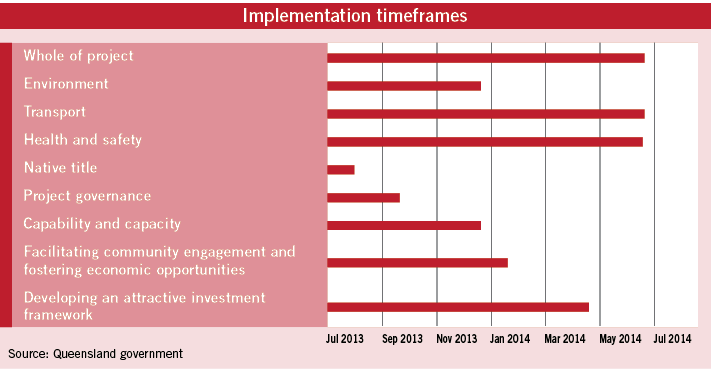The Australian state of Queensland’s Department of Natural Resources and Mines (DNRM) has released an action plan to implement a best practice policy framework to recommence uranium mining in the state. The stated aim is to have all necessary work done for the government to be able to assess uranium mining proposals by July 2014. No legislative changes are considered necessary, and there is approximately A$10 billion (US$9.52 billion) worth of in-ground uranium resource in Queensland.

亚司特国际律师事务所
布里斯班办公室
合伙人
Partner
Ashurst
Brisbane
In our 20 March 2013 update, we reported on the key recommendations contained in the report of the Uranium Mining Implementation Committee, which was released on 18 March 2013. The Queensland government has since released its response to the committee’s report, on 12 September 2013, outlining the key actions it will take to introduce a best practice policy framework for the recommencement of uranium mining in Queensland. The government expects to have all the necessary guidelines and polices in place to commence the assessment of uranium mining applications by July 2014.
Key findings
The government has endorsed the committee’s key finding that the environmental issues arising from uranium mining are similar to other forms of metalliferous mining, including surface water impacts from tailings dams, groundwater impacts, land clearing and mine site rehabilitation. Given these similarities, the government’s position is that the existing principles and basis of the state’s legislative framework applicable to mining can be suitably applied to uranium activities, with minimal change.
Royalty recommendations
The government is seeking to establish an attractive investment environment in Queensland that facilitates opportunities for industry, but also balances the need for an appropriate return to the state and community. As part of this, led by Queensland Treasury and Trade, the government will commence assessment of the committee’s royalty recommendations with a decision on an appropriate framework to be developed by mid-2014.
Whole of project assessment
The government intends assessing uranium mine proposals as “co-ordinated projects” but with clarity on assessment processes, including engagement with the Australian government on its involvement and generally improving the efficiency of regulatory processes.
Safety and environmental impacts
The Queensland government is seeking to ensure that there is a robust framework in place that supports safe mine site operations. This will be supported through joint actions between the DNRM, Queensland Health (QH), the Australian government and industry.
The Queensland government will ensure that environmental impacts of uranium activities are managed consistently with contemporary standards being implemented for other mining projects.
Transportation and infrastructure
The government will apply the same tenure, landholder rights, access and compensation principles for uranium activities as other forms of metalliferous mining. The government intends to provide a clear framework and promote efficiencies in the transport and export of uranium. The government will, as a member of the Australian Uranium Council, request consideration on the issue of harmonisation of transport and logistics across jurisdictions, and develop and capture its preference for uranium export to occur through existing licensed ports (currently limited to Darwin and Adelaide).

Michael Sheng
亚司特国际律师事务所
上海代表处
合伙人
Partner
Ashurst
Shanghai
It will develop a memorandum of understanding between the Department of Transport and Main Roads and QH to allow transport inspectors to conduct compliance inspections of uranium transport. Further, a review of the guiding principles that underpin the radiation protection programmes for the transport of radioactive material will also be conducted to determine whether the principles are applicable to uranium.
Native title
As with other mining process, the government is seeking to ensure the interests of indigenous communities and native title rights are captured in assessment processes. In doing so, statutory process for indigenous interests will apply to uranium proposals as it does to other resources. The Queensland government will also commence discussions with the Australian government to minimise the negotiation demands placed on Traditional Owner groups.
Industry oversight
The Queensland government intends transitioning its current interdepartmental committee on uranium mining to a whole of government Uranium Mining Oversight Committee. In addition, there will be regional uranium mining stakeholder committees with industry and other representation included. Copies of the report and action plan can be found on the Queensland DNRM website.
John Briggs is a partner at Ashurst and the leader of the firm’s environment and development practice team in Brisbane. Michael Sheng is a partner at Ashurst in Shanghai
亚司特国际律师事务所上海代表处
上海市南京西路1168号中信泰富广场3408-10
Ashurst Shanghai office
Suites 3408-10, CITIC Square
1168 Nanjing Road West, Shanghai
邮编 Postal code: 200041
电话 Tel: 86 21 6263 1888
传真 Fax: 86 21 6263 1999
专栏联系人 Key contact:
盛冕 Michael Sheng
(上海代表处合伙人 Partner, Shanghai)
电子信箱 E-mail:
michael.sheng@ashurst.com
www.ashurst.com























